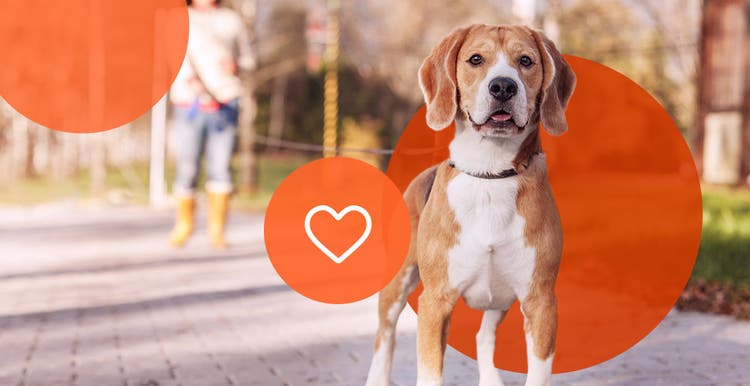Playtime principles promote good behavior.
"Sit. Sit! I said SIT!"
If that sounds familiar, your dog's training might need a little work. But don't worry - you don't have to run intense drills to get your pup in line.
Instead, take a cue from playtime. Keep reading for dog training games you can try at home - plus, see how elements of play can help improve your dog's training.
Three Simple Dog Training Games
Training your dog doesn't have to be strict or rigid. Try thinking of training as teaching your dog to play. Here are three dog training games to get you started.
How to Teach a Dog to Come and Follow
Pick a quiet place and fill your pocket with small treats. Walk around and give your dog a treat if they follow you. Then give the "follow" command, walk away without looking back and give them a treat if they obey. Change up your speed and direction, and reward your dog for following.
How to Teach a Dog to Drop It
Leash your dog and toss one of their favorite toys on the floor. When they pick it up, either call them to you or gently pull them to you on the leash. Put one hand on the toy and say "give." With your other hand, offer a treat. If your dog releases the toy, praise them and give the treat as a reward.
How to Teach a Dog Recall Training through Hide-and-seek
Tell your dog to sit and stay, and then hide somewhere (and keep your location easy at first). Call your dog's name, wait, and repeat it if needed. When your dog finds you, give them a treat and praise! Instead of hiding yourself, you can also hide a treat or toy, and then guide your dog until they find it.
Expert Tips for Making Dog Training into a Game
Brett Suttle, owner of Rude Dog K9 Training Company, has trained dogs for more than 20 years, including for K9 search and rescue. When Suttle first meets a dog and their owner, he asks a series of questions, including if the dog can sit on command. And if it takes three or more tries, he says he doesn't consider the dog trained.
"They view the command as a request, which means that obedience is on the dog's terms, not yours," he explains.
The good news is you can train your dog to respond to commands and to continue doing behaviors you want - while curbing the undesirable ones. Here are some expert tips to help make training more fun and effective for you and your dog:
Tip 1: Always Use Positive Reinforcement
"Training, like play, should be upbeat with positive reinforcement for the dog," Suttle says.
Just as dogs prefer different play styles, they also respond to different types of positive reinforcement. Your pet's personality, motivations and maturity may factor into what works best for them.
Some positive reinforcements to try include food, praise, toys and play. Food rewards can be a good place to start, as they're sure to capture your dog's attention. However, food can quickly lose its effectiveness. As your training progresses, try phasing out food and integrating praise and play, which can be more effective and relevant in the long run.1
So, what does that look like in practice? Suttle gives the example of teaching your dog to sit and stay. If your dog loves balls, tell them to sit and stay before giving the ball. After a few repetitions, they'll realize they get the ball when they complete the desired task.
Tip 2: Know When to Train
Wagging, running and jumping? These signs tell you that your dog is in the mood to play - and that means they're likely in a good mental and physical space for training, too.
Tip 3: Help Your Dog Focus
Distracted dogs are not good learners. Suttle notes that discomforts such as ear infections or itchy flea bites could take your dog's mind off their training. So take care of whatever's distracting them before getting to work.
You can also minimize distractions throughout training sessions. After 15 to 20 minutes of training, Suttle recommends giving your dog a break by sitting them in their kennel for a few minutes. Dogs think in pictures, he says, and this downtime lets them absorb and process what just happened without taking in new information.
Once your dog achieves the desired task - whether it's following, dropping it or recall - Suttle says, this is a great time to reward them with the thing they love best: playtime.
1. “Dog Training: Phasing out Food Lures and Rewards.” DogTime, 19 Aug. 2016, dogtime.com/dog-health/general/1534-dog-training-food-lures-rewards-dunbar.
Related Articles

Puppy Parenting: Our Downloadable Guide
New puppy? Whether this is your first go-round or your fifth, we know that so much goes in to raising healthy, happy pups. Check out our free guide, also available to download!







